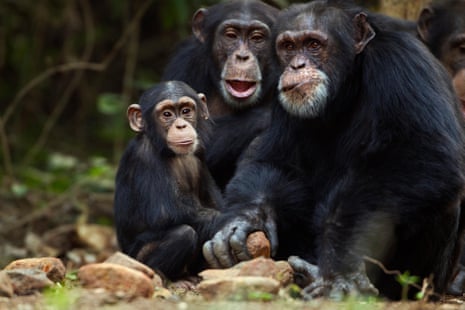Up to a third of Africa’s great apes are threatened by a boom in mining projects for minerals required for the renewable energy transition, new research shows.
An estimated 180,000 gorillas, bonobos and chimpanzees are at risk due to an increase in demand for critical minerals such as copper, lithium, nickel and cobalt, a study has found. Many of those minerals are required for clean energy technologies such as wind turbines and electric cars. Researchers say the boom in demand is driving destruction of tropical rainforests which are critical habitats for Africa’s great apes.
“Africa is experiencing an unprecedented mining boom threatening wildlife populations and whole ecosystems,” researchers wrote in the paper, published in Science Advances. Africa is home to an estimated 30% of the world’s mineral resources, and substantial production increases in renewable energy are expected to drive up demand.
Mining harms apes through habitat loss, pollution and disease. It can also make habitats more accessible to hunters and farmers, as roads are carved into forest. More than two-thirds of primate species are already threatened with extinction.
“A shift away from fossil fuels is good for the climate but must be done in a way that does not jeopardise biodiversity,” said lead researcher Dr Jessica Junker from the non-profit conservation organisation Re:wild. “In its current iteration it may even be going against the very environmental goals we’re aiming for … It is crucial for everyone to adopt a mindset of reduced consumption.”

Understanding the net impact of mining for energy transition minerals on biodiversity is challenging. The climate crisis also threatens great apes, and clean energy technologies are important to avoiding the worst effects of global heating.
The paper – written in collaboration with researchers from the German Centre for Integrative Biodiversity Research and the Martin Luther University Halle-Wittenberg – used data on operational and pre-operational mining sites in 17 African countries and mapped areas where mining and high ape densities overlapped. It defined a buffer area of 10km around the mine as the area that would be directly affected and a 50km buffer for indirect impacts.
The paper found that the largest mining impacts on apes were in the west African countries Liberia, Sierra Leone, Mali and Guinea. In Guinea, more than 23,000 chimpanzees (83% of the population) could be directly or indirectly affected by mining activities.
Even the most ecologically sensitive areas are generally not protected. Unrelated to apes, the paper found that 20% of mining areas overlapped with regions that were considered unique for biodiversity, or labelled “critical habitats”. Junker said: “Companies, lenders and nations need to recognise that it may sometimes be of greater value to leave some regions untouched to mitigate climate change and help prevent future epidemics.”
Researchers said more could be done to mitigate mining’s effects on endangered species. Mining companies are not required to make biodiversity data publicly available. It is possible that the impact of mining projects on great apes and other species is even higher than this paper found, according to the researchers.
Biodiversity offset schemes are typically developed to last as long as the mining project does, although impacts on great apes are permanent. “Mining companies need to focus on avoiding their impacts on great apes as much as possible and use offsetting as a last resort, as there is currently no example of a great ape offset that has been successful,” said Dr Genevieve Campbell from the International Union for Conservation of Nature, who is also a senior researcher at Re:wild.








